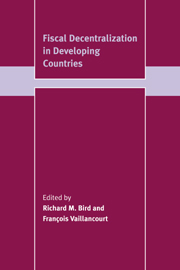Book contents
- Frontmatter
- Contents
- List of tables
- List of contributors
- Preface
- 1 Fiscal decentralization in developing countries: an overview
- 2 China: evaluating the impact of intergovernmental fiscal reform
- 3 India: intergovernmental fiscal relations in a planned economy
- 4 Indonesia and Pakistan: fiscal decentralization – an elusive goal?
- 5 Morocco and Tunisia: financing local governments – the impact on infrastructure finance
- 6 Colombia: the central role of the central government in fiscal decentralization
- 7 Argentina: fiscal federalism and decentralization
- 8 South Africa: an intergovernmental fiscal system in transition
- 9 Bosnia-Herzegovina: fiscal federalism – the Dayton challenge
- Index
2 - China: evaluating the impact of intergovernmental fiscal reform
Published online by Cambridge University Press: 09 October 2009
- Frontmatter
- Contents
- List of tables
- List of contributors
- Preface
- 1 Fiscal decentralization in developing countries: an overview
- 2 China: evaluating the impact of intergovernmental fiscal reform
- 3 India: intergovernmental fiscal relations in a planned economy
- 4 Indonesia and Pakistan: fiscal decentralization – an elusive goal?
- 5 Morocco and Tunisia: financing local governments – the impact on infrastructure finance
- 6 Colombia: the central role of the central government in fiscal decentralization
- 7 Argentina: fiscal federalism and decentralization
- 8 South Africa: an intergovernmental fiscal system in transition
- 9 Bosnia-Herzegovina: fiscal federalism – the Dayton challenge
- Index
Summary
In China's fiscal system, the distinction blurs as among tax policy reform, tax administration reform, and intergovernmental fiscal reform. So linked are they that changes in any one of the three legs of the public financing structure will automatically affect the other two:
all tax rates and bases are centrally determined, so structural changes have direct impacts on local as well as central government revenues;
revenues from these centrally determined taxes are shared between the central and local governments, partly on a derivation basis with the retention rates varying by tax, and partly in the form of an ad hoc grant;
the tax administration system is decentralized enough that local governments have derived some fiscal autonomy from a creative implementation of the tax assessment and collection system.
The comprehensive fiscal reform in China in 1994 altered the structure of the major taxes, changed the responsibilities for tax administration, and modified the revenue-sharing arrangements. It also curtailed the ability of local governments to use “back-door” approaches to revenue mobilization. As a result, the entire intergovernmental system was redefined. This chapter is an attempt to evaluate the impact of these changes.
In the next sections, the Chinese intergovernmental fiscal system before and after the 1994 reform is described and the underlying revenue concerns that drove the reform are considered. Most of the remainder of the chapter is an evaluation of the impacts of the 1994 reform on the intergovernmental fiscal system. A concluding section presents a summary comparison of Chinese fiscal decentralization with the world practice.
- Type
- Chapter
- Information
- Fiscal Decentralization in Developing Countries , pp. 49 - 77Publisher: Cambridge University PressPrint publication year: 1999
- 3
- Cited by



